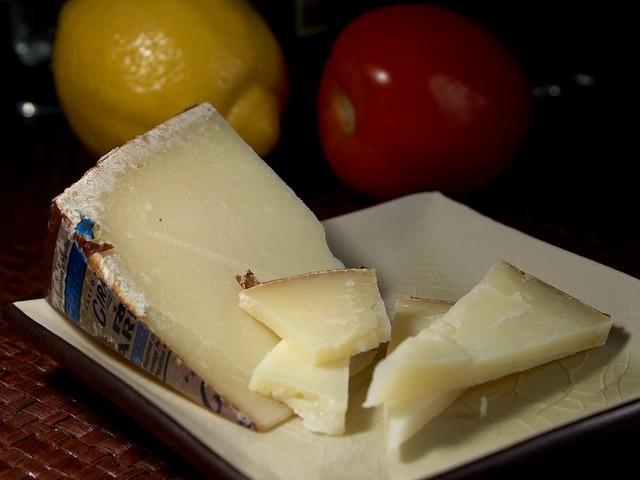Pecorino cheese is a delicious Italian cheese that can be used in many dishes. However, not everyone has access to Pecorino cheese or does not like the taste of it. Fortunately, there are few substitutes for this type of cheese available! This blog post will discuss what you should use instead if you cannot find or do not like Pecorino Cheese.
The Italian cheese trinity is made up of three cheeses: Grana, Parmigiano, and Pecorino. These three cheeses are the foundations of Italian cheese making.
What is Pecorino cheese?
Pecora is a type of cheese made from sheep’s milk, while Pecorino is derived from the Latin term pecora, which means “sheep.”
There are many different terms and definitions for the flavor of pecorino cheese, much like there are for a fantastic wine. From the smokey fragrance to the straw undertones, to name a few.
In the most ordinary sense, the Pecorino can be described as hard cheese, salty cheese made from sheep’s milk, and sometimes goat’s milk.
Three varieties must be described differently:
- “pecorino fresco” ie fresh cheese,
- “semi-stagionato” matured cheese and
- “stagionato” which means is experienced or old in Italian.
The longer it matures, the saltier and harder it will be, making it easier to grate, not surprisingly, in Italian cuisine, it is served several times with pasta, how grated it is.
Traditionally, long-aged cheese was made and aged for 8-12 months, with a strong flavor that becomes smokier and sharper with age. The cheese has a fat content of 45-50% and is crumbly, granular, pale yellow in color, smoky in taste, spicy, usually salty but nutty, and powerful in flavor.
Pecorino Romano isn’t the only pecorino cheese available.
Pecorino Sardo (Fiore Sardo)
Pecorino Sardo is made on Sardinia’s island of Sardinia, predominantly in Cagliari, Nuoro, Oristano, and Sassari. Some claim that it has been produced on the island since the Bronze Age. The cheese is produced from 100% unpasteurized Sarda sheep’s milk.
Traditionally matured for 6 months, during the maturing, it will taste more robust. The percentage of fat in the cheese is 35-40%, and it has a dense, oily, hard texture. The color is pale yellow, with an odorous burnt caramel flavor/aroma. The spice taste becomes stronger with time.
Pecorino Toscano (Toscanello)
Pecorino Toscana (DOP) is mostly produced in Tuscany, although it may also be found in lesser amounts in Umbria and Lazio. It has a long and illustrious history that dates back to the Etruscans. It is produced using pasteurized and unpasteurized milk. Animals also benefit from forage and hay, which assist to nourish them. The pleasantly green, soft, creamy flavor of Fresh Pecorino Toscano, which has been aged for 20 days, is delightful.
The cheeses are aged for at least four months, during the aging process developing a deeper flavor and one that becomes stronger as it ages. The fat content of the cheese is 40-45%, the texture of the ripe cheese is creamy, crumbly, dense, solid, white in color, bitter in taste / nutty, salty, sweet and meaty. Its aroma is green, grassy. With maturation, the creaminess decreases, the spicy flavor intensifies, the sweetness balances with the bitterness.
What cheese can I substitute for Pecorino?
Parmesan Cheese the Best Substitutes for Pecorino
Parmesan cheese is one of the Holy Trinity of cheeses and a member of the Holy Trinity. If we ask people what comes to mind when they think about Italy, Parmesan answers one of the first five.
Parmesan is a hard Italian cheese made from cow’s milk with a specified fat content of 32 percent. The cheese is pressed into the form of a huge disc with a diameter of 35-45 cm and an oiled outside crust. A disc has a weight range of 44 to 88 pounds. Parmesan is a hard cheese that originated in the 13th century. Parmesan has a very distinct flavor, which is why just a tiny amount of it is required in each dish. Even from a spice, Parmesan has an overpowering flavor that needs only a minor quantity to provide months – if not years of enjoyment.
Only cheese produced in Parma, Reggio Emilia, Modena, Mantua, or Bologna may be labeled parmigiano reggiano. Only animals grazing freely and consuming green pasture can provide the milk.
We classify Parmigiano-Reggiano into three stages of maturity:
- fresco (maturing in less than 18 months),
- vecchio (medium-aged Parmesan with a maturation period of 18-24 months),
- stravecchio (very old cheese with a maturation period of 24-36 months) based on its degree of aging.
Parmesan is a more expensive substitute for Pecorino cheese, but it will definitely add its own flavor to the dish you are making.
Grana Padano – “Poor Man’s Parmesan” Cheap alternative for Pecorino
The Po Valley is home to Italy’s oldest hard cheese, Grana Padano, produced in the region for 900 years. It is produced from cow’s milk and matures for a year or two. Its name comes from its origin in the Po Valley. It’s made of cow’s milk and takes 1-2 years to mature. It comes from cheese factories with a diameter of 35-45 cm and a weight of 44-88 pounds.
It has a sweet, fruity flavor similar to Parmesan and has a delicious, buttery aroma.
Matured Asiago Cheese
Semi-hard cheese is produced from cow’s milk in Italy and has a diameter of 30 to 36 cm, a height of 9 to 12 cm, and 17 to 26 pounds. The cheese bark is smooth, even, and straight on all sides. The Province of Trentino, in the Italian Alps, is known for its Asiago cheese. Fresh and aged Asiago is produced on the Po plain through the Asiago plateau to the alpine pastures of Trentino province.
- Fresh Asiago is a cheese made from whole milk that has been aged for at least twenty days. It’s white or slightly straw-yellow in color and has distinct but irregular holes with a taste reminiscent of freshly milked milk; delectable and delicious, it melts wonderfully on the tongue, leaving an irresistibly sweet, slightly acidic taste.
- Matured Asiago (Asiago Stagionato): Asiago d’Allevo, also known as matured Asiago cheese, is produced from semi-skimmed milk and is aged 3-15 months. It has a straw-yellow color, tiny to medium-sized holes, and a distinctive pungent flavor that grows with age. This is an excellent substitute for Romano Pecorino cheese.
Asiago has three stages of maturity:
- Asiago Mezzano (Medium Asiago) (4-6 months of aging),
- Asiago Vecchio (Matured Asiago) (maturation for 10 to 15 months)
- Asiago Stravecchio (Highly matured Asiago) (maturing for more than 15 months).
Piave Softer Alternative for Pecorino Romano
It takes its name from the northern Italian Piave River, which is where it originates. Its popularity stems from the fact that it is easy to use.
Piave is a cheese similar to Parmigiano-Reggiano in flavor and texture but softer. It’s an Italian cheese that’s like a distant relative of Parmigiano-Reggiano. The flavor is a slightly sweet flavor, with a bit of sweetness and fruitiness. It takes around a year to mature, with a milder and smoother texture than Parmigiano-Reggiano.
Spanish Manchego Cheese Aged- Delicous alternative from Spain
The region’s two most well-known features are the windmills of Don Quixote and Manchego, which are produced in the area. The term “Manchego” refers to a local ethnic group and the celebrated cheese of the region.
It’s a type of hard sheep cheese known for its toughness. It is produced in 3-pound cylinders, solely in the name region. Its bark isn’t very thick, but it is elastic and has a waxy covering that makes it seem dark. It’s hard on the inside but crumbly and easy to cut and grate. The maturation process takes three to five months.
A parquet-style pattern characterizes its bark due to its protected designation of origin: it can only be given to Manchegs, who have earned the Spanish DOC‘s protection. The pattern was originally created by placing new cheeses in wicker baskets made of esparto grass, but a patterned plastic cover replaced this.
It’s one of Spain’s most famous cheeses. It is delicious, not to mention that Spaniards are proud of it. It may be eaten on its own with little bread and Serrano ham for snacking, making it a desired delicacy in its own right.
The semi-curado manchego is still flexible and has a high water content at the age of just 3 months. The flavor is tart, fruity, green with some hay undertones.
The aged curado manchego after 6 months has caramel, walnut flavors, and varying degrees of acidity. The interior of the cheese, which has been aged for a long time, hardens, precipitates crystals, as in parmesan cheese, and develops a crumbly texture. The milk caramel appears in its flavors, and the taste will be sweet, long-lasting.
It is available in four distinct levels of graduation:
- fresco: aged for at least 60 days, mild and sweet
- semicurado: matured for at least 180 days
- curado: matured for 12 months
- anejo: matured for 12-24 months
Can you substitute mozzarella for Romano cheese?
Mozzarella can’t be substituted for Romano cheese. In fact, mozzarella is made from water buffalo milk and has a completely different taste than sheep’s or cow’s milk cheeses. It does not have any of the characteristics that make pecorino romano so appealing. Pecorino Romano doesn’t melt and has a sharp, salty taste. Mozzarella does not have any of those attributes.
Is pecorino cheese like Parmesan?
No, pecorino romano is not like Parmesan cheese. It’s a popular alternative to Parmesan, but its distinct flavor and texture make it unique from the latter. Pecorino Romano also doesn’t melt in the same way as Parmesan does when heated up on pizzas or baked pasta dishes. However, there are similarities between the two, such as their limited shelf life and high level of saltiness that makes them a common choice for adding flavor to pasta or pizza dishes.
Parmesan has a longer maturation period compared with Pecorino Romano cheese. It takes around 18 months to make Parmesan, while pecorino romano only requires around 12. This is the reason why Parmesan has a stronger, more intense flavor than Pecorino Romano. Parmesan cheese also melts when it’s baked or added to dishes that require high heat.
Where can I buy Pecorino cheese?
You can find Pecorino cheese in specialty grocery stores, Italian restaurants, or online.
Bottom line
I think the best substitute for pecorino romano is surprisingly called Parmigiano Reggiano, But the cheeses listed above are worth exploring.
Check out our other article on the best gruyere substitutes.
Last updated: September 24, 2023



Comments are closed.